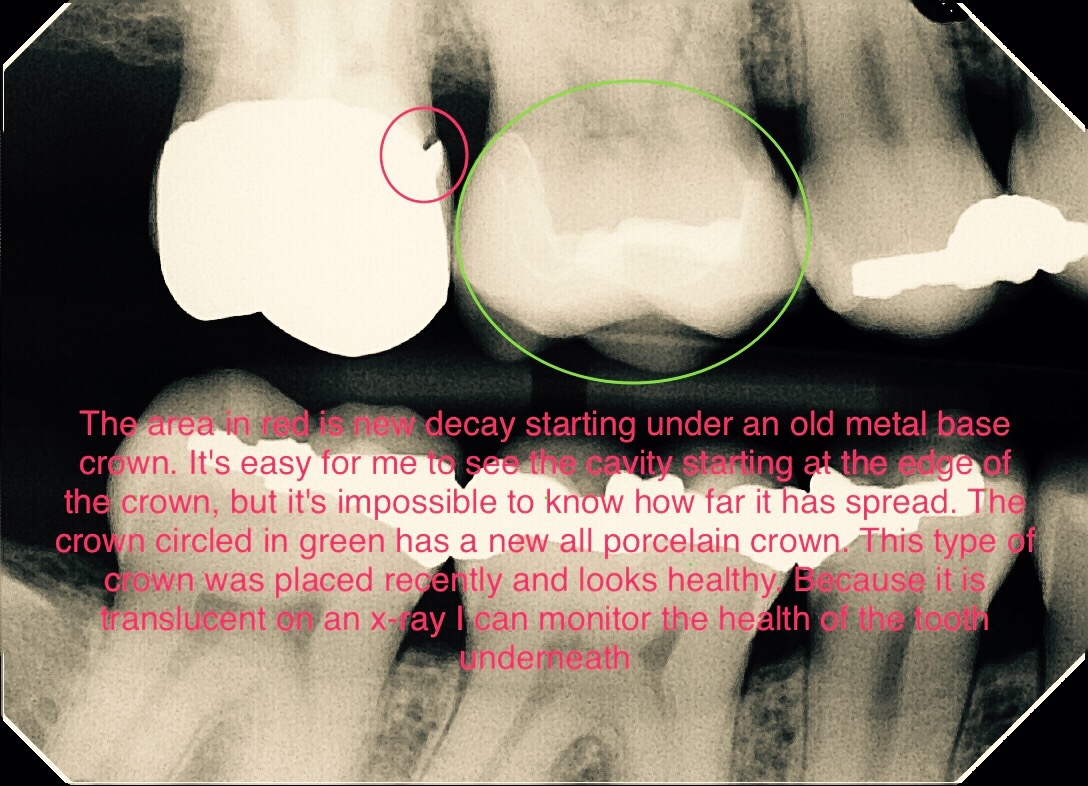
In my dental practice I am either cementing a crown on a tooth or preparing for one on almost a daily basis. This means that I’m having conversations with people routinely that center around both what the crown is and what it is treating. People often want to know what a crown accomplishes differently than a dental filling.
Tooth Fillings
A dental filling is usually used to seal the inside of the tooth where tooth structure has been lost to decay or a cavity. These areas need to be resealed to protect the inside of the tooth. A crown’s primary purpose isn’t a so much to seal the tooth but to protect it from future damage. When a significant portion of the tooth has been lost to damage from cavities, a crown is often suggested to protect the remaining tooth from fracturing or breaking. Teeth may also begin to crack or fracture if they are weak, if we clench abnormally hard on them, or just with the use and abuse of time. Many of us have fillings from when we were children, and although these fillings can often last for 20-30+ years, the tooth will eventually begin to fracture around the filling or develop new decay. In these cases it is suggested that the tooth is covered for protection with a crown.
Crowns vs. Fillings
While this is all well and good, crowns aren’t something that should be arrived at lightly. I’m not insensitive to the fact that a crown is an investment in both time and money. This means I struggle daily to make sure I help people arrive at a treatment plan that works best for them. I want people to know what the best option is for their health, what I would do for my wife’s help in the same situation, but I also want to arrive at a plan that works best for the individual. Digital photography and digital x-rays and made these conversations easier. People can see what we’re discussing and it aids them in making an informed decision
Porcelain Crowns
If we determine that the crown is the best option, we can then also have a conversation about what the crown is fabricated from. In the beginning of my career, The vast majority of crowns placed in the past were metal based. These crowns were either porcelain fused to metal or a gold crown. Nowadays I rarely use metal base crowns.
Newer all porcelain crowns can be milled, or even more impressively, pressed to shape. There are a few advantages to porcelain over metal based crowns. For starters, they are considerably more esthetic. Porcelain crowns are very life like and sometimes very difficult to discern from natural enamel. Porcelain can also be bonded directly to the tooth creating a surprisingly strong seal that helps protect the tooth from future decay. The advantage I initially didn’t expected to appreciate so much, is that they are translucent in an X-ray. This allows me to see beneath the crown and monitor for problems or cavities. People sometime present with an old metal based crown that is beginning to develop decay along the root of the tooth. They often ask how advance the decay is and if we have any time to wait or prioritize. This is tough, since I cannot see through the metal on an x-ray, I may have no idea if the decay is still relatively small or if it is more advanced. It is disheartening to remove a metal crown and find advanced decay that minimize treatment options. Porcelain helps mitigate this risk, since it can be monitored for problem
Crowns for Teeth
All the porcelain crowns we fabricate are pressed to shape. This is a little more time consuming than milling a crown out of a block of porcelain, but it can result in a very esthetic and accurate crown. If we are fabricating a front crown or any crown we are concerned about the esthetics, we want to make sure the shape and color are perfect. Again, early in my career, the best option was to take pictures and sometimes send the patient to a lab to meet with a ceramist. In recent years I’ve partnered with a ceramist who comes to the office to meet with the patient. This makes it more convenient for the patient and gives us a customized result.
